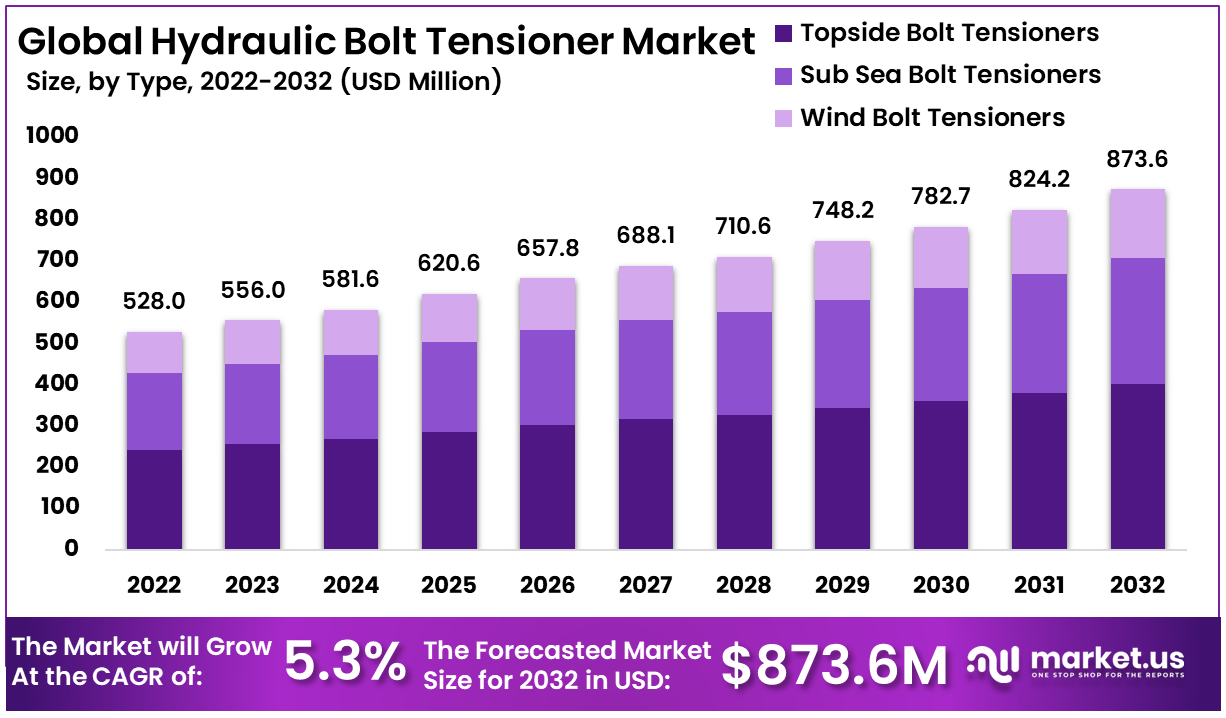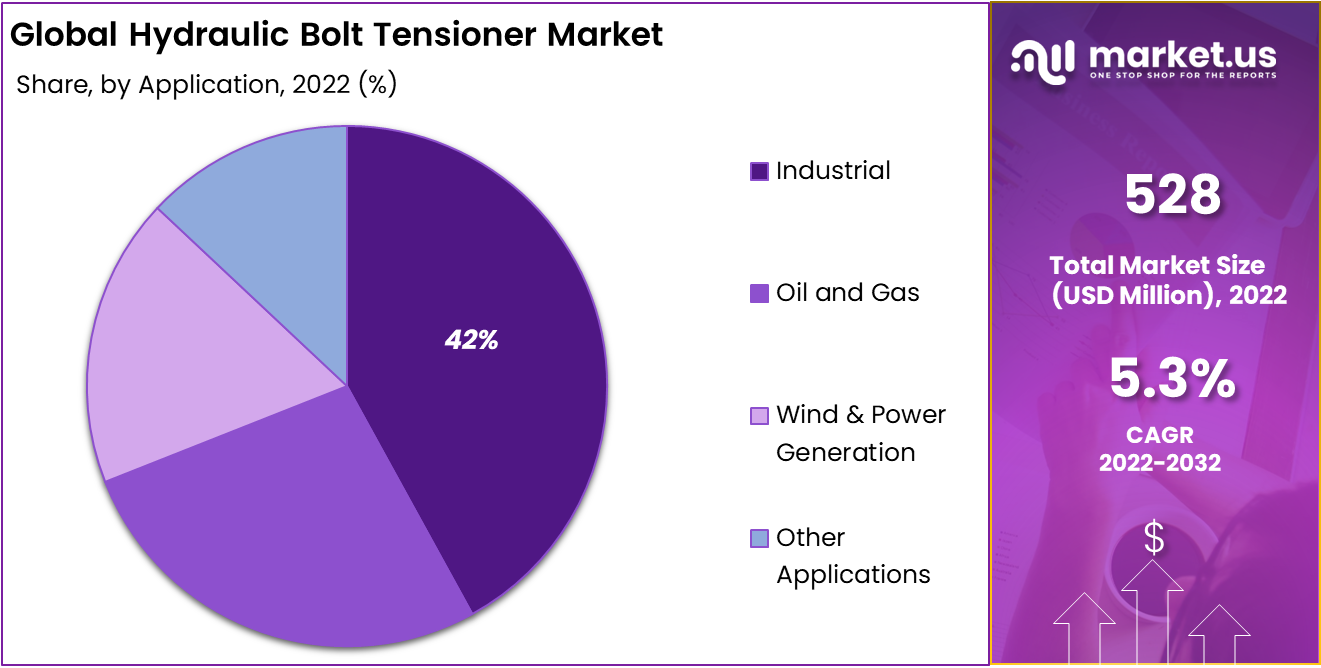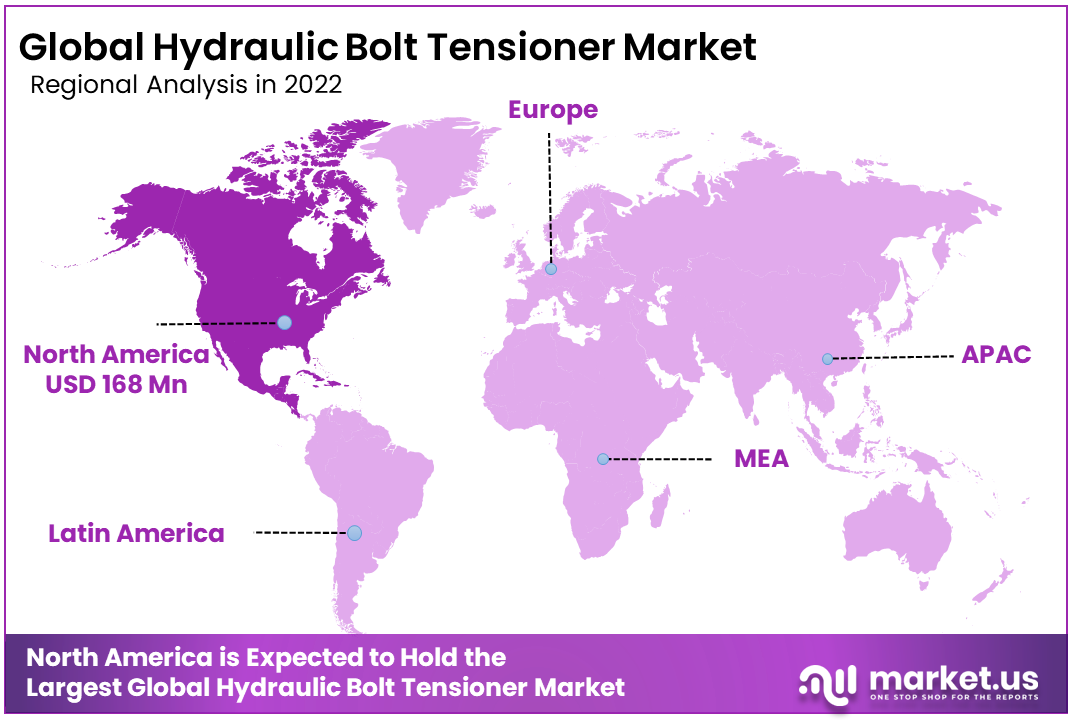Global Hydraulic Bolt Tensioner Market By Type (Topside Bolt Tensioners, Subsea Bolt Tensioners, and Wind Bolt Tensioners), By Application (Oil and Gas, Wind & Power Generation, Industrial, and Other Applications) By Region and Companies - Industry Segment Outlook, Market Assessment, Competition Scenario, Trends, and Forecast 2023-2032
- Published date: Sep 2023
- Report ID: 15612
- Number of Pages: 300
- Format:
- keyboard_arrow_up
Quick Navigation
Report Overview
The Global Hydraulic Bolt Tensioner Market size is expected to be worth around USD 873.6 Million by 2032 from USD 528 Million in 2022, growing at a CAGR of 5.30% during the forecast period from 2023 to 2032.
The hydraulic bolt tensioner market refers to the industry segment involved in the production, distribution, and utilization of hydraulic devices specifically designed to apply controlled tension to bolts or fasteners in various mechanical assemblies. These tensioners operate based on hydraulic principles, utilizing fluid pressure to generate a precise and uniform force on bolts, ensuring optimal clamping force and integrity in industrial applications.
The primary objective of hydraulic bolt tensioners is to facilitate accurate and efficient bolt tightening, which is crucial for maintaining structural integrity, preventing leakage, and ensuring operational safety across diverse sectors such as construction, manufacturing, energy, and transportation.

Actual Numbers Might Vary in the Final Report
Driving Factors
Demand for Efficient and Reliable Bolting Solutions
The hydraulic bolt tensioner market is influenced by an array of compelling driving factors that collectively shape its growth trajectory. One of the primary drivers is the escalating demand for efficient and reliable bolting solutions across various industries, such as oil and gas, power generation, manufacturing, and construction.
The inherent advantages offered by hydraulic bolt tensioners, including their ability to apply accurate and uniform tension, minimize human error, and enhance safety in critical applications, have significantly contributed to their rising prominence.
Furthermore, the ongoing advancements in technology and engineering have led to the development of innovative hydraulic bolt tensioners with features such as automated control systems, real-time monitoring capabilities, and compatibility with various bolt sizes and types. These technological advancements not only cater to the evolving requirements of industries but also address concerns related to productivity, time efficiency, and operational cost savings.
Restraining Factors
Installation and Operation Has Complex and Highest Investment Initially
In the realm of the hydraulic bolt tensioner market, several restraining factors have emerged as critical determinants influencing its dynamics. These factors, albeit posing challenges, play an integral role in shaping the market landscape. Firstly, the intricate nature of hydraulic bolt tensioner installation and operation has contributed to a certain level of complexity, deterring potential adopters who might prefer simpler mechanical alternatives.
Moreover, the initial investment required for acquiring hydraulic bolt tensioning systems, encompassing equipment and training costs, can be a notable deterrent, particularly for small and medium-sized enterprises with budget constraints.
Secondly, the market’s reliance on industries such as oil and gas, energy, and heavy machinery exposes it to fluctuations in these sectors. Economic downturns or reduced investments in these industries can consequently lead to decreased demand for hydraulic bolt tensioners. This susceptibility to external economic conditions underscores the need for diversification in application sectors to mitigate potential risks.
Additionally, the maintenance and servicing of hydraulic bolt tensioners require specialized knowledge and skills, leading to a dependence on skilled technicians. This dependency can be limiting, especially in regions facing shortages of trained personnel.
Growth Opportunities
The global hydraulic bolt tensioner market stands poised as a realm of substantial growth opportunity. This growth trajectory can be attributed to several pivotal factors that converge to create a conducive environment for market expansion.
The primary driver of this potential is the persistent expansion of industries reliant on heavy machinery and equipment, where the efficacy of bolted connections is of paramount importance. As industries such as construction, manufacturing, energy, and transportation continue to evolve and diversify, the demand for precision, reliability, and safety in bolted connections escalates, thereby magnifying the relevance of hydraulic bolt tensioners.
Furthermore, the overarching trend towards operational efficiency and the mitigation of downtime in industrial operations further accentuates the prominence of hydraulic bolt tensioners. These devices offer rapid, uniform, and controlled application of bolt tension, thereby streamlining assembly and maintenance processes. The imperative to reduce labor-intensive procedures and enhance workplace safety propels the adoption of hydraulic bolt tensioners across diverse sectors, promising sustained market growth.
Latest Trends
In the dynamic landscape of industrial equipment and machinery, the global hydraulic bolt tensioner market is currently witnessing a confluence of transformative trends that bear significant implications for various sectors. Among the latest trends, the industry is experiencing a discernible shift towards technologically advanced solutions characterized by the integration of smart features and digital capabilities.
This includes the incorporation of IoT-based monitoring systems, which enable real-time tracking of bolt tensioning operations, thereby enhancing precision and operational efficiency. Furthermore, there is a notable emphasis on safety enhancements within the hydraulic bolt tensioner market.
Manufacturers are investing in the development of innovative mechanisms that ensure optimal operator safety during tensioning procedures. This is particularly relevant in industries where bolted connections play a crucial role in maintaining structural integrity and operational reliability.
Sustainability considerations have also begun to influence the market landscape. Eco-friendly hydraulic fluids and energy-efficient components are gaining prominence, aligning with the global push towards environmentally responsible practices.
Additionally, the market is witnessing a demand surge for customized solutions tailored to specific industry requirements, prompting manufacturers to diversify their product portfolios and offer adaptable tensioning solutions catering to diverse applications.
By Type Analysis
The Topside Bolt Tensioners Type is Expected to Dominate This Market
Based on type, the market for hydraulic bolt tensioners is classified into topside bolt tensioners, subsea bolt tensioners, and wind bolt tensioners. Topside bolt tensioners have emerged as a dominant segment within the market for hydraulic bolt tensioners due to their versatility, widespread applicability, and their role in serving industries that operate in above-water environments. Their dominance can be attributed to several factors that highlight their significance in various industrial sectors.
Firstly, topside bolt tensioners cater to a diverse range of industries, including manufacturing, construction, automotive, and general machinery assembly. These industries frequently require precise and controlled bolt tightening for assembling, maintaining, and ensuring the operational efficiency of structures and equipment on land or in onshore facilities.
The accessibility of topside environments makes these tensioners convenient and efficient tools for addressing the diverse fastening needs across multiple industries. Secondly, the topside environment offers favorable conditions for equipment operation and maintenance, leading to greater ease of use and reduced operational complexity.
Unlike subsea environments with their challenges of high pressures, corrosive conditions, and limited access, topside bolt tensioners operate under more controlled circumstances. This makes topside tensioners an attractive choice for industries that prioritize operational efficiency and cost-effectiveness.
By Application Analysis
Industrial Application is Expected to Dominate This Market
Based on application, the market for hydraulic bolt tensioners is classified into oil and gas, wind & power generation, industrial, and other applications. The dominance of the industrial segment within the market for hydraulic bolt tensioners is a result of the segment’s broad and pervasive applicability across a diverse array of industries. The industrial sector, characterized by its vast scope and continuous demand for precision engineering and maintenance, has positioned itself as a driving force behind the market’s growth and prominence.
Primarily, the industrial segment encompasses a wide spectrum of industries, including manufacturing, construction, automotive, aerospace, and general machinery assembly. These industries rely heavily on hydraulic bolt tensioners to ensure the integrity, safety, and operational efficiency of various structures and equipment.
The need for controlled and accurate bolt tightening is a common requirement in these industries, spanning applications such as equipment assembly, maintenance, repair, and overhaul. Furthermore, the industrial sector’s constant pursuit of operational excellence and quality assurance has led to the adoption of advanced technologies and precision engineering practices.
Hydraulic bolt tensioners, with their ability to provide controlled and consistent axial load to bolts, align well with the stringent tolerances and performance standards demanded by modern industrial processes. The industrial segment’s inclination towards automation, digital integration, and reliable fastening methods has contributed significantly to the dominance of hydraulic bolt tensioners in this context.

Global Hydraulic Bolt Tensioner Market Key Segmentation:
Based on Type
- Topside Bolt Tensioners
- Sub Sea Bolt Tensioners
- Wind Bolt Tensioners
Based on Application
- Oil and Gas
- Wind & Power Generation
- Industrial
- Other Applications
COVID-19 Impact Analysis
The widespread disruptions caused by lockdowns, restrictions, and labor shortages significantly affected the manufacturing processes associated with hydraulic bolt tensioners. Factory closures and reduced operational capacities led to production slowdowns, thereby affecting the availability of these critical tools.
Additionally, the intricate supply chains that sustain the production and distribution of hydraulic bolt tensioners encountered substantial challenges. Delays in raw material procurement, transportation bottlenecks, and limitations in international trade all contributed to a supply-demand imbalance.
From a demand perspective, the pandemic’s influence on industries like construction, automotive, and energy further reverberated in the hydraulic bolt tensioner market. Fluctuating project timelines, deferred maintenance schedules, and decreased investments impacted the need for these tools.
Industries that rely on hydraulic bolt tensioners for their operations had to navigate the complexities of reduced budgets and revised priorities, further dampening the market’s growth prospects.
Regional Analysis
North America dominated the global market in terms of revenue share in 2022, with more than 32%. North America has established its dominance in the global hydraulic bolt tensioner market through a combination of strategic factors and industry strengths. The region’s supremacy can be attributed to its advanced industrial infrastructure, strong emphasis on technological innovation, well-developed manufacturing capabilities, and a culture of stringent safety standards and compliance.
The United States and Canada, in particular, have cultivated an environment conducive to technological advancements and engineering excellence. The presence of leading industrial machinery manufacturers, research institutions, and engineering expertise has fostered the development of cutting-edge hydraulic bolt tensioner solutions. These solutions often integrate automation, data analytics, and Industry 4.0 principles, aligning with the global trend toward smart manufacturing.
Furthermore, North America’s commitment to safety regulations and occupational health standards has propelled the demand for high-quality bolt tensioning equipment. As industries prioritize worker safety and operational reliability, the region’s manufacturers have responded by producing hydraulic bolt tensioners that adhere to the strictest safety protocols.

Key Regions and Countries Covered in this Report:
- North America
- The US
- Canada
- Europe
- Germany
- France
- The UK
- Spain
- Italy
- Russia & CIS
- Rest of Europe
- APAC
- China
- Japan
- South Korea
- India
- ASEAN
- Rest of APAC
- Latin America
- Brazil
- Mexico
- Rest of Latin America
- Middle East & Africa
- GCC
- South Africa
- United Arab Emirates
The global hydraulic bolt tensioner market is extremely dynamic. All major companies are trying to increase their market share. Atlas Copco AB, WREN HYDRAULICS, and WREN HYDRAULICS are major market players across the globe.
Market Key Players:
- Atlas Copco AB
- SKF AB
- SPX FLOW (SPX Corporation)
- HYTORC
- Siempelkamp Tensioning Systems
- WREN HYDRAULICS
- Pilgrim International
- Nord-Lock
- Hi-Force
- SCHAAF GmbH
- Beck Industries
- FPT – Fluid Power Technology.
- Hydraulics Technology Inc. (HTI)
- TorcUp Inc.
- ITH bolting technology
- Powermaster Engineers Pvt Ltd.
- Technofast Industries Pty Ltd
- Other Key Players
Report Scope:
Report Features Description Market Value (2022) US$ 528 Mn Forecast Revenue (2032) US$ 873.6 Mn CAGR (2023-2032) 5.3% Base Year for Estimation 2022 Historic Period 2016-2022 Forecast Period 2023-2032 Report Coverage Revenue Forecast, Market Dynamics, COVID-19 Impact, Competitive Landscape, Recent Developments Segments Covered By Type-Topside Bolt Tensioners, Subsea Bolt Tensioners, and Wind Bolt Tensioners; By Application- Oil and Gas, Wind and Power Generation, Industrial, and Other Applications Regional Analysis North America: The US and Canada; Europe: Germany, France, The UK, Italy, Spain, Russia & CIS, and the Rest of Europe; APAC: China, Japan, South Korea, India, ASEAN, and the Rest of APAC, Latin America: Brazil, Mexico, and Rest of Latin America, Middle East & Africa: GCC, South Africa, United Arab Emirates, and Rest of Middle East & Africa Competitive Landscape Atlas Copco AB, SKF AB, SPX FLOW (SPX Corporation), HYTORC, Siempelkamp Tensioning Systems, WREN HYDRAULICS, Pilgrim International, Nord-Lock, Hi-Force, SCHAAF GmbH, Beck Industries, FPT – Fluid Power Technology., Hydraulics Technology Inc. (HTI), TorcUp Inc., ITH bolting technology, Powermaster Engineers Pvt Ltd., Technofast Industries Pty Ltd, Other Key Players Customization Scope Customization for segments, region/country-level will be provided. Moreover, additional customization can be done based on the requirements. Purchase Options We have three licenses to opt for Single User License, Multi-User License (Up to 5 Users), Corporate Use License (Unlimited User and Printable PDF) Frequently Asked Questions (FAQ)
What is the Hydraulic Bolt Tensioner Market Size in the Year 2022?The Global Hydraulic Bolt Tensioner Market size was USD 528 Million in 2022, growing at a CAGR of 5.30% during the forecast period.
What is the Hydraulic Bolt Tensioner Market CAGR During the Forecast Period?The Global Hydraulic Bolt Tensioner Market size is expected to grow at a CAGR of 5.30% during the forecast period from 2023 to 2032.
What is the Hydraulic Bolt Tensioner Market Size During the Forecast Period 2023-2032?The Global Hydraulic Bolt Tensioner Market size is expected to be worth around USD 873.6 Million by 2032 during the forecast period.
 Hydraulic Bolt Tensioner MarketPublished date: Sep 2023add_shopping_cartBuy Now get_appDownload Sample
Hydraulic Bolt Tensioner MarketPublished date: Sep 2023add_shopping_cartBuy Now get_appDownload Sample - Atlas Copco AB. Company Profile
- SKF AB
- SPX FLOW (SPX Corporation)
- HYTORC
- Siempelkamp Tensioning Systems
- WREN HYDRAULICS
- Pilgrim International
- Nord-Lock
- Hi-Force
- SCHAAF GmbH
- Beck Industries
- FPT – Fluid Power Technology.
- Hydraulics Technology Inc. (HTI)
- TorcUp Inc.
- ITH bolting technology
- Powermaster Engineers Pvt Ltd.
- Technofast Industries Pty Ltd
- Other Key Players
- settingsSettings
Our Clients
| Single User $4,599 $3,499 USD / per unit save 24% | Multi User $5,999 $4,299 USD / per unit save 28% | Corporate User $7,299 $4,999 USD / per unit save 32% | |
|---|---|---|---|
| e-Access | |||
| Report Library Access | |||
| Data Set (Excel) | |||
| Company Profile Library Access | |||
| Interactive Dashboard | |||
| Free Custumization | No | up to 10 hrs work | up to 30 hrs work |
| Accessibility | 1 User | 2-5 User | Unlimited |
| Analyst Support | up to 20 hrs | up to 40 hrs | up to 50 hrs |
| Benefit | Up to 20% off on next purchase | Up to 25% off on next purchase | Up to 30% off on next purchase |
| Buy Now ($ 3,499) | Buy Now ($ 4,299) | Buy Now ($ 4,999) |












